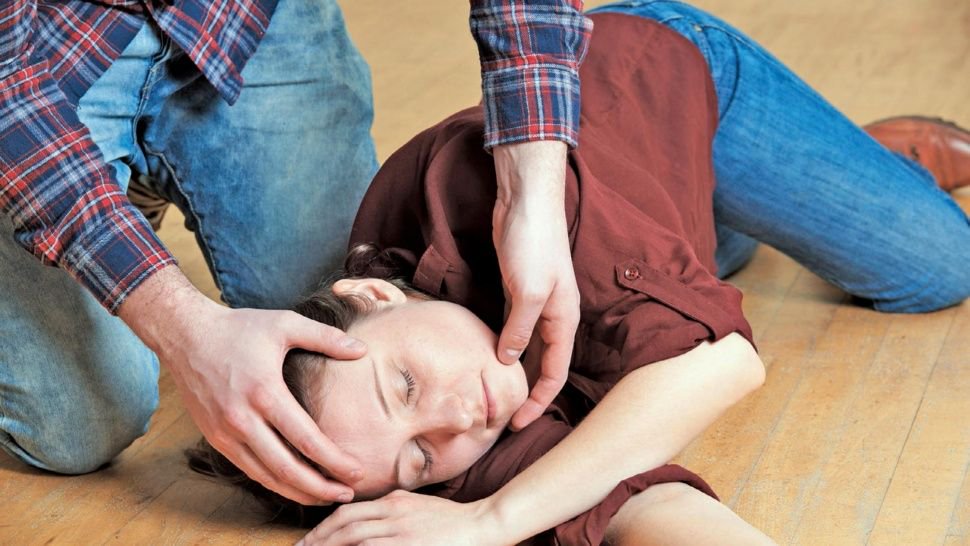Epileptic Patient

If someone has got epilepsy, then follow the below steps to provide them with instant first-aid
- Remain quiet and stay with the person.
- If they have got liquid or food in their mouth, move them onto their side right away.
- Keep them safe and shield them from damage.
- Place something delicate under their head and remove any tight attire from them.
- Give comfort to the person until they recover.
- Time the seizure, if it’s possible with you.
- Roll the individual onto their side after the snapping stops.
Try neither to keep anything into their mouth nor to move the individual, except if they are at risk.
When Should You Call an Ambulance for an Epileptic Seizure?

- The seizure goes on for at least five minutes or longer than what is typical for the individual.
- The next seizure quickly continues.
- The individual isn’t reacting for over five minutes after the seizure ceases.
- The individual gets problem while breathing after the jolting stops.
- It is the initially known seizure by the person.
- The seizure took place in water.
- The individual gets harmed.
- You are in uncertainty.
What Happens During Epilepsy?

Epilepsy is a type of disorder in the central nervous system where the brain gets abnormal, leading to seizures or periods of unusual conduct, sensations, and loss of awareness. Everyone has got the chance to get epilepsy in them.
Epilepsy takes place both in females and males of all ages, backgrounds, races, and ethnic. The symptoms of a seizure can vary immensely. A few people with epilepsy look blankly for a couple of moments during a seizure. On the other hand, some just grab their arms or legs.
If you have got a single seizure, then it doesn’t symbolize that you have epilepsy. You need to face at least two unjustified seizures to have an epilepsy treatment.
Medical treatment or sometimes surgery can help to get control of seizures for the majority of people having epilepsy. On the other hand, some category of patients needs lifetime treatment to have control over their seizures. A few youngsters with epilepsy may exceed the condition with age.
How to Manage Your Epilepsy?

Some epileptic patients tend to get treatment naturally and alternate therapies such that they could calm their indications or supplement their medicines. From acupuncture and biofeedback to vitamins and herbs, there are several options from which one can choose.
There are several natural medications which are well researched by scientists while there are still many which are not. It is advisable to have general medicine over natural treatment due to lack of evidence.
If you’re keen on adding something new to your epilepsy treatment routine, have a conversation with your primary care physician. You may locate that some regular medications can supplement your present treatment plan. However, a few herbs are risky and can interface with successful prescribed remedies.
Working with a specialist to find the correct medications for you can enable you to evaluate the advantages and dangers.
-
Vitamins:
Several vitamins are known to be helpful to decrease the number of seizures that takes place due to epilepsy. However, remember that vitamins alone don’t work well. They may enable a few meds to work efficiently or lessen your vital measurement. Go to your primary care physician before using them.
-
Vitamin B-6:
This vitamin is used to have control of a rare type of epilepsy, which is known as a pyridoxine-dependent seizure. This category of epilepsy grows soon after the birth of a baby or even inside the womb. It’s due to your body’s failure to use Vitamin B-6 appropriately.
-
Vitamin E:
A few people with epilepsy may likewise have a vitamin E deficiency. A 2016 study gave the conclusion that vitamin E expands cancer prevention agent capacity. This result proves that it helps decline seizures in individuals with epilepsy whose side effects not controlled by traditional medications. The investigation leads to the conclusion that vitamin E might provide valuable outcome with generic pills for epilepsy.
One research reported on 18th April 2019 by the University of Melbourne compared phenytoin with levetiracetam, an anticonvulsant. The results showed that the perfect outcomes are upon giving one of the drugs after the other. This protocol of treatment stopped 75% of the seizures that children face.
-
Change in the Diet:
Specific changes in the diet plan may likewise help decline seizures. The best-realized eating regimen is the ketogenic diet. It spotlights on eating a higher proportion of fats.
The keto diet is known as a low-carb as well as a low-protein diet. This diet style is thought to help in decreasing seizures.
Usually, doctors prescribe the keto diet for epileptic kids. Numerous individuals find it quite challenging. This type of diet style may provide other treatment measures to help decrease seizures.
In 2002, Johns Hopkins Medicine formed the Atkins diet as a high-fat and low-carb option to the ketogenic diet for grown-ups with epilepsy.
-
Self-Control and Bio-Feedback:
A few people with epilepsy try to control the movement of their brain. It is done to decrease the chances of seizures. The hypothesis is that if you can know the symptoms of a seizure, you might almost certainly stop it.
Several people with epilepsy get aura symptoms 20 minutes before a seizure occurs. You may see irregular scents, see unusual lights, or have a hazy vision.
Some symptoms include:
- A feeling of discomfort.
- Lower in the confidence level due to loss of hope.
- Getting the feel of extreme tiredness.
- Terrible pain in the brain.
Methods of self-control are utilized to diminish the power of the seizure once it gets close. There are a few strategies which require great preoccupation and core interest.
Examples are as follows:
- Walking.
- Increase in focus.
- Drenching yourself in an undertak ing.
- Sniffing a solid scent.
Another method includes bio-feedback. Biofeedback uses electrical sensors to modify cerebrum waves. One study reported that biofeedback decreased seizures in individuals with epilepsy. These people are not able to deal with their symptoms.
Physical advisors ordinarily use biofeedback. In case you’re comfortable with this plan, look for an expert with some good reviews.
It might be hard to deal with your condition with biofeedback and self-control alone. The two methods require time, steadiness, and consistency to ace. If you choose to go this course, be understanding. Try not to diminish or quit taking any endorsed drugs without the approval of your doctor.
An experiment conducted at the University of Texas at San Antonio on July 22, 2019. Here they removed new neurons that were growing after an injury in the brain of mice. As a result, they found that the epileptic seizures has reduced in them.
On 30th April 2019, The Picower Institute at MIT suggested that glial cells help in keeping a balance between ions that required by the neurons to avoid seizures.
On 16th May 2019, Vanderbilt University Medical Center stated that after the surgery of an epilepsy patient, the brain network activity has improved.
What Are the Challenges with Epilepsy?

Some problems a person will face with Epilepsyare:
-
Falling
If you fall during an epileptic seizure, you can harm your head or even break a bone.
-
Difficulty in breathing
If you have epilepsy, then take care not to suffocate while swimming or taking a bath.
-
Accidents in a car
An epileptic seizure that causes either loss of control or mindfulness can be hazardous if you’re working with some hardware or driving a vehicle.
-
Problems before giving birth
During the phase of pregnancy, a seizure is harmful to both mother and child, and certain anti-epileptic meds increment its danger. If you have epilepsy and you’re thinking about getting pregnant, then seek your private doctor consultation. Most ladies with epilepsy can end up pregnant and have sound children. You’ll be deliberately checked all through pregnancy, and medication needs to be balanced. Significantly, you work with your private medications while planning for pregnancy.
-
Emotional health issues
Individuals with epilepsy are bound to have mental issues. Some of them are wretchedness, uneasiness, and self-destructive musings. Problems might be a consequence of troubles managing the condition itself just as drug symptoms.
-
Status epilepticus
This condition occurs if you’re getting consistent seizure action for over five minutes or have got several repetitive seizures without getting full control of mind in the middle of them. Individuals with status epilepticus have an increased danger of brain harm throughout life.
-
Sudden Unexpected Death in Epilepsy (SUDEP)
People with epilepsy have also got a little danger of sudden death. The reason for this is still not known.
On 20th June 2019, the University of Connecticut reported that sudden death and epilepsy linked to the bad gene.
What Does an epileptic Patient Face During Epilepsy?

It is different in different individuals. Let’s see things that happen during epilepsy.
- Blackout or even confused mind.
- A spasm with no temperature (no fever).
- The individual is slow to react towards the guidelines or questions for a small period.
- Control in the gut or bladder is lost.
- The individual all of a sudden fall without any reason.
- The individual turns out to be firm, all of a sudden, for no evident reason.
- A sudden spell of chewing, with no explicit logic.
- A sudden spasm of blinking without reasonable boosts.
- For a brief period, the person appears to be confused and unfit to talk.
- The motion of the people that appear to be not correct.
- The individual ends up afraid for no evident reason; they may even frenzy or become irate.
- Change in senses, for example, smell, contact, and sound.
- The arms, legs, or body twitch, in children these will show up as a bunch of quick jerking motion.
The doctors have divided epileptic seizures into three main categories:
-
Partial Seizure:
A partial seizure implies that an epileptic action occurred in some part of the patient’s brain. It is of two kinds:
Simple partial seizure – the patient is much comfortable and in senses during the seizure. In several cases, it is understandable that the patient is likewise mindful of their environment, even though the seizure is in advancement.
Complex partial seizure – the patient’s level of comfort has harmed. The patient will not be able to recall the seizure, and if they do, their memory will be unclear.
-
Generalized seizure:
A generalized seizure happens when both parts of the brain have epileptic movement. The patient’s awareness lost while the seizure is in advancement.
Tonic-clonic seizures: It is the most famous generalized seizure. They cause lost cognizance, body firmness, and shaking.
Tonic seizures: This seizure results in getting muscle stiffness. Generally, the muscles present in arms, back, and legs get affected. It may also lead a person to fall on the ground.
Absence seizures: Previously called petit mal seizures, these include losing awareness for a short period where the individual seems to be looking steadily at nothing much important. Absence seizures frequently react well to treatment.
Atonic seizures: lost muscle control makes the individual drop all of a sudden.
Clonic seizures: This relates jerking and repeated movements of the muscle.
-
Secondary generalized seizure:
A secondary generalized seizure takes place after the partial seizure, which gets spreads to the two parts of the cerebrum. As this advancement occurs, the patient loses consciousness.
Is There a Difference Between Epilepsy and Seizure?

Seizures are just a symptom of epilepsy. Epilepsy characterized as having “at least two unjustifiable seizures,” as per Johns Hopkins Medicine.
A few people have a solitary seizure or seizures that not connected to epilepsy. As reported by the United Kingdom’s Epilepsy Society, non-epileptic seizures are not because of electrical movement in mind. The causes can be physical or emotional.
There are various kinds of seizure. It may differ between individuals with epilepsy, so in two people, the condition may appear to be not unique. Hence, it tends to be known as a spectrum disorder.
In conclusion, not all people who get seizures have epilepsy. Only people who face seizures twice might consider as an epileptic condition. Once you start your treatment and follow the instructions very well, you can live a normal life peacefully. Thus, no need to panic if you are an epileptic patient, you necessitate working hard on managing this condition.
Do not forget to follow us on our blog.
https://fitnesshealthforever.com/
There is much information that is about to come for you. These tips will be helpful for you 😉



